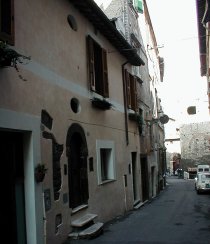Opposite, on the left, we go to Via del Riserraglio, where in the ancient time were the Posterula of Vesta. At the civic number 4 and 6 there are two nice small buildings: the first, dated back to the year 1353, with a main door with travertine ashlar and the second, dated back to the XVI century, with travertin portal and with travertin windows at the first floor. Both the buildings show on the main door the coat of arms, formed by a rosette with a San Bernardino da Siena's monogram. This tortuous way drives us to the characteristic Piazza del Riserraglio.
From here we can go down across Via Vesta; a
downhill stretch takes us to Via degli Stabilimenti. This
way, restructured not long ago, is the zone of the ex paper
mills. We can admire the beautiful view on the gorge of the
water fall and then we'll go to the hill which takes us to
the Castrovetere quarter.
So we arrive in the heart of the quarter, Piazza della
Cittadella; a silent narrow alley takes us to the small
square of the Tempio
di Vesta. We'll go on into Via della Sibilla. On the
right, going on in Vicolo Ciaccia, we arrive in Piazza
San Giorgio, dedicated to the homonymous saint, as the
small church.
That church in the past was dedicated to San Michele Arcangelo and was built with the attached convent of Santa Chiara's nuns, who moved here from the old convent of Santa Caterina, located in Piazza D.Tani, in 1571. But, returning to go through Via della Sibilla, we can surpass the Rione Castrovetere's entrance door and we can walk across San Martino bridge, which connects the city to the old acropolis, divided by a deep ditch. Immediately after the tower house put to defend the bridge, on the left we go down across Via delle Mole, where you can enjoy excellent view of the gorge.
Going through Via della Sibilla, we meet at
first, at the civic number 22, the architectural building
of the XVI century belonging to the patrician families of
Tivoli De Rossi-Susanna, then, on the left, at the civic number
8, the Principe Orsini's Palace. That building, dated 1200,
was built on the ruins of Loreius Tiburtinus's home (he was
a man of the ancient Rome).
In 1356 the prince Giulio Orsini assembled some noblemen
of the city to withstand to the advance of the army of
Filippo II, king of Spain, coming from Napoli. In the
basements of the Palace assembled the citizens who took
sides for Orsini's family against Colonna's family. Via
della Sibilla leads to Piazza Rivarola, dominated by an
example of tower house with clock. To go to Villa Gregoriana
is necessary to cross Ponte Gregoriano.
From Piazza Rivarola we take the hill on the left, Via del
Ponte Gregoriano, and then, halfway up the hill, we'll take
Via dei Sosii, always on the left.
You can admire on the left the Regnoni-Macera Palace, of the
XVI century, with its nice stone-portal. Here the Pope Gregorio
XVI, in the far 1834, stopped to see the narrow underground
passages excavated under Monte Catillo and to be present at
the procession of the Madonna di Quintiliolo. In front of
the building there is a construction of the Middle Ages (Viscardi's
home) in which showsup a window provided with centering, probably
Angelo da Tivoli's work; there are a lot of roman elements
re-used. Then we can pass in front of the ancient entrance
of San Biagio church, always on the right at the civic numbers
53-57; now, arrived at the Gemma's fountain (a midwife very
famous among the parturients of Tivoli), begins Via Domenico
Giuliani. Immediately after, on the right, we start to go
up across Vicolo Torlonia. We'll arrive to the church of Sant'Andrea,
risen from the ruins of Diana's temple. The first building
is dated 1285, but it was rebuilt in the second half of the
XIII century, with the annexed bishop Filippo Gezza de Rufinis's
cloister. From the church we'll go on across Vicolo Lolli,
which takes its name from the small building (XVI century)
of the Lolli di Lusignano family, constructed on the old Diana's
baths, at the civic number 4 of Via dei Sosii. Crossed the
arch, we are in Via del Trevio, which this time we travel
back wards, so arriving at Largo Garibaldi, our point of departure.
Surroundings
-
The Sacro Speco

An impressive complex of buildings which almost looks as if it is one with the surrounding rock...
To know more
-
Rocca Pia
Built on the place where Callisto II Borgia's Castle was situated...
-
Church of St.Peter
It was built on the rests of a roman villa...
Tivoli's attractions

Patrocinio Comune di Tivoli
Assessorato al Turismo




